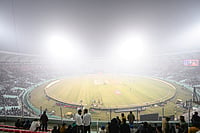FIVE thirty am at Baramati, small town in Maharashtra. At Dynamix Dairy's 300 milk collection centres, villagers queue up with their bicycles and cans brimming with fresh milk. The milk will now be chilled at the collection centres, and later in the morning, transported to Dynamix's sprawling campus. By evening, all the milk will be cheese, moving in hi-tech refrigerated trucks, on the highway to Mumbai and Delhi.
In the meantime, at Trikaya Farm at Talegaon near Pune, fresh iceberg lettuce has been packed into trucks, which are about to set off for the two metros. Every hour, the driver stops to check whether the temperature inside the storage compartment is just right for the lettuce to remain fresh.
Hundreds of kilometres away, at Kochi in Kerala, some more trucks have just set off, carrying fillet of fish. And yet some more, carrying mutton patties from Al-Kabeer at Medha village in Hyderabad district.
These trucks—and many others—will all converge in a finely-calculated logistical operation, to give you the burger you can bite into at your nearby McDonald's outlet.
For McDonald's, there is a lot of sweat between the burger and the customer. The retail outlet—which puts the burger together before the customer—is just the tip of the iceberg. A lot happens before the burger finally makes it to the plate.
McDonald's runs over 23,000 outlets in 109 countries, and follows the same style of operation in India as it does in all other countries where it functions. "We source the ingredients from the best available options in the country, no matter where it is located in the country. For us, quality overrides all geographical barriers and considerations," says Ragvinder S. Rekhi, vice-president, McDonald's India.
Interestingly enough, nothing going into the McDonald's burger is manufactured by the company itself. It outsources everything. McDonald's began developing the food chain three years before it actually opened its restaurants. For this, Big Mac and its international supplier partners worked with local companies to develop products. At present, McDonald's has over 35 suppliers who help put together the burger one buys from its retail outlets.
The US-based MNC has introduced a new concept in food transport in India: what it refers to as its "cold chain". This transports ingredients from their places of manufacture, all over the country, to the centralised distribution system of Radhakrishna Foodland, an independent food storage and distribution company which runs the Foodland chain of food supermarkets. Foodland takes care to store the products in controlled environments in Mumbai and Delhi, and makes retail supplies to McDonald's outlets daily.
"The purpose of the cold chain is to transport the semi-finished products at a fixed temperature, to keep the food fresh and prevent loss of moisture. And this temperature is maintained throughout the journey and the products remain as fresh at the cooking table, as they were at the time of harvest," says H. Shriram, general manager, Foodland. It's like transporting food over long distances in a frost-free refrigerator.
And nothing, barring the final compilation of bun, cheese and patty, is done by hand. The entire process is totally automated using technology brought to India specially for the McDonald's project.
While, for the moment, the McDonald's restaurants are located at New Delhi and Mumbai only, the ingredients owe their origin to almost all parts of the country. Consider this: The buns used in the burger come from Shah Bector & Sons at Khopoli in Maharashtra and Cremica Industries in Phillaur, Punjab; the sesame seeds topping the buns come from Ghaziabad in Uttar Pradesh; iceberg lettuce from Trikaya Agriculture (from the owners of Trikaya Advertising) in Talegaon. Soon, lettuce will also come from Ferrocon Farms of Dehradun, Meena Agritech of Delhi, and Ooty Farms in Tamil Nadu.
The lettuce is an exclusive variety developed specially by McDonald's through its suppliers. The variety has high moisture content and is difficult to grow in dry, arid areas. "McDonald's has introduced new culture farming techniques to develop this lettuce leaf, which is similar to the one used in McDonald's burgers anywhere else in the world. This technique is unique because we can now grow lettuce, which is primarily a winter product, throughout the year and in rainshed areas," says Samar Gupta, managing director, Trikaya Agriculture.
The vegetable and chicken patties are manufactured by Vista Processed Foods and Kitran Foods at Taloja in Maharashtra. While Vista is a joint venture between OSI Food Industries of US and Maharashtra-based Cardinal Foods, Kitran is a joint venture between Vista and Kitchen Range Foods of UK, a specialist in vegetarian fast food. Vista makes the chicken products and Kitran takes care of the veggie cuisine. The two companies themselves source their raw material from yet another circle of suppliers. For instance, the chicken comes from Riverdale Farms of Taloja while the vegetables for the patties come from Finns Frozen Foods and Jain Foods located at Nasik and Jalgaon in Maharashtra respectively.
McDonald's helped these two companies get the technology and expertise from their foreign partners. To cater to Indian tastes and preferences, Vista and Kitran, although located in the same premises, maintain entirely different operational set-ups for vegetarian and non-vegetarian products. "The concept of separating vegetarian and non-vegetarian food on religious grounds exists only in India. So we've had to maintain two different manufacturing lines so that there is no cross-contamination or mixing," says Jose Azavedo, CEO, Vista and Kitran. The plant even has separate toilets for people working in the two lines.
The mutton and mutton patties are sourced from Medah, Hyderabad-based Al-Kabeer while the fish fillet patties are supplied by Kochi-based Amalgam Foods. Other smaller ingredients are sourced from companies based in Ludhiana, New Delhi, Hyderabad, Noida and so on.
McDonald's entire requirement of cheese is met by the multi-crore Dynamix group which runs the state-of-the-art Dynamix Dairy Industries in the milk-surplus area of Baramati in Maharashtra and is promoted by a group of industrialists led by G.P. Goenka. In the absence of sufficient demand and processing facilities, a large amount of milk was being thrown away by farmers in Baramati—the constituency of Congress strong-man Sharad Pawar. The entry of McDonald's and setting up of Dynamix not only ensured utilisation of the milk but also a steady supply of milk to the dairy. Today, the company has the capacity to process about 500,000 litres of milk and produce about 4,800 metric tonnes of cheese daily.
To improve quality standards at Dynamix, McDonald's introduced Dynamix to two of its global suppliers—Schreiber Foods and Erie Foods of the US. The two companies not only brought in the latest processes and technology for a large number of value-added dairy products, but also entered into a joint venture and long-term supply contract worth $12 million annually with Dynamix. Today, Dynamix is not only an exclusive supplier of cheese to McDonald's, it also manufactures the entire range of cheese for Britannia Industries and also exports some of its produce.
However, while McDonald's has taken active interest in setting up the supplier chain for its burgers—most of them having been set up from scratch—the multinational does not have any stake in any of them and encourages these companies to diversify into other businesses or take up other buyers. All companies supplying to McDonald's follow the internationally-acclaimed Hazard Analysis and Critical Control Points system wherein both incoming and finished goods are tested chemically and microbiologically. Analysis is carried out in sterile laminar flow to determine total viable count, E-coli staph and salmonella, to prevent dispatch of food with any kind of infection or contamination.
So next time you munch into your favourite McBurger, you can rest assured it has travelled a long distance to reach you.






















